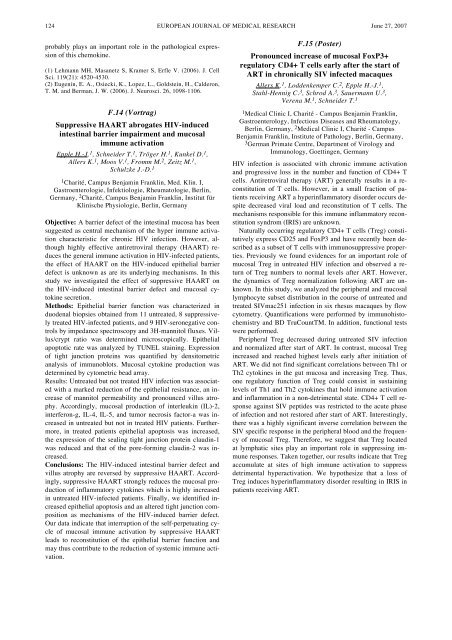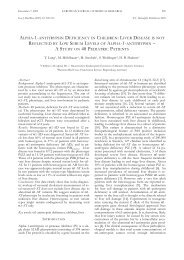European Journal of Medical Research - Deutsche AIDS ...
European Journal of Medical Research - Deutsche AIDS ...
European Journal of Medical Research - Deutsche AIDS ...
You also want an ePaper? Increase the reach of your titles
YUMPU automatically turns print PDFs into web optimized ePapers that Google loves.
124 EUROPEAN JOURNAL OF MEDICAL RESEARCH<br />
June 27, 2007<br />
probably plays an important role in the pathological expression<br />
<strong>of</strong> this chemokine.<br />
(1) Lehmann MH, Masanetz S, Kramer S, Erfle V. (2006). J. Cell<br />
Sci. 119(21): 4520-4530.<br />
(2) Eugenin, E. A., Osiecki, K., Lopez, L., Goldstein, H., Calderon,<br />
T. M. and Berman, J. W. (2006). J. Neurosci. 26, 1098-1106.<br />
F.14 (Vortrag)<br />
Suppressive HAART abrogates HIV-induced<br />
intestinal barrier impairment and mucosal<br />
immune activation<br />
Epple H.-J. 1 , Schneider T. 1 , Tröger H. 1 , Kunkel D. 1 ,<br />
Allers K. 1 , Moos V. 1 , Fromm M. 2 , Zeitz M. 1 ,<br />
Schulzke J.-D. 1<br />
1 Charité, Campus Benjamin Franklin, Med. Klin. I,<br />
Gastroenterologie, Infektiologie, Rheumatologie, Berlin,<br />
Germany, 2 Charité, Campus Benjamin Franklin, Institut für<br />
Klinische Physiologie, Berlin, Germany<br />
Objective: A barrier defect <strong>of</strong> the intestinal mucosa has been<br />
suggested as central mechanism <strong>of</strong> the hyper immune activation<br />
characteristic for chronic HIV infection. However, although<br />
highly effective antiretroviral therapy (HAART) reduces<br />
the general immune activation in HIV-infected patients,<br />
the effect <strong>of</strong> HAART on the HIV-induced epithelial barrier<br />
defect is unknown as are its underlying mechanisms. In this<br />
study we investigated the effect <strong>of</strong> suppressive HAART on<br />
the HIV-induced intestinal barrier defect and mucosal cytokine<br />
secretion.<br />
Methods: Epithelial barrier function was characterized in<br />
duodenal biopsies obtained from 11 untreated, 8 suppressively<br />
treated HIV-infected patients, and 9 HIV-seronegative controls<br />
by impedance spectroscopy and 3H-mannitol fluxes. Villus/crypt<br />
ratio was determined microscopically. Epithelial<br />
apoptotic rate was analyzed by TUNEL staining. Expression<br />
<strong>of</strong> tight junction proteins was quantified by densitometric<br />
analysis <strong>of</strong> immunoblots. Mucosal cytokine production was<br />
determined by cytometric bead array.<br />
Results: Untreated but not treated HIV infection was associated<br />
with a marked reduction <strong>of</strong> the epithelial resistance, an increase<br />
<strong>of</strong> mannitol permeability and pronounced villus atrophy.<br />
Accordingly, mucosal production <strong>of</strong> interleukin (IL)-2,<br />
interferon-g, IL-4, IL-5, and tumor necrosis factor-a was increased<br />
in untreated but not in treated HIV patients. Furthermore,<br />
in treated patients epithelial apoptosis was increased,<br />
the expression <strong>of</strong> the sealing tight junction protein claudin-1<br />
was reduced and that <strong>of</strong> the pore-forming claudin-2 was increased.<br />
Conclusions: The HIV-induced intestinal barrier defect and<br />
villus atrophy are reversed by suppressive HAART. Accordingly,<br />
suppressive HAART strongly reduces the mucosal production<br />
<strong>of</strong> inflammatory cytokines which is highly increased<br />
in untreated HIV-infected patients. Finally, we identified increased<br />
epithelial apoptosis and an altered tight junction composition<br />
as mechanisms <strong>of</strong> the HIV-induced barrier defect.<br />
Our data indicate that interruption <strong>of</strong> the self-perpetuating cycle<br />
<strong>of</strong> mucosal immune activation by suppressive HAART<br />
leads to reconstitution <strong>of</strong> the epithelial barrier function and<br />
may thus contribute to the reduction <strong>of</strong> systemic immune activation.<br />
F.15 (Poster)<br />
Pronounced increase <strong>of</strong> mucosal FoxP3+<br />
regulatory CD4+ T cells early after the start <strong>of</strong><br />
ART in chronically SIV infected macaques<br />
Allers K. 1 , Loddenkemper C. 2 , Epple H.-J. 1 ,<br />
Stahl-Hennig C. 3 , Schrod A. 3 , Sauermann U. 3 ,<br />
Verena M. 1 , Schneider T. 1<br />
1 <strong>Medical</strong> Clinic I, Charité - Campus Benjamin Franklin,<br />
Gastroenterology, Infectious Diseases and Rheumatology,<br />
Berlin, Germany, 2 <strong>Medical</strong> Clinic I, Charité - Campus<br />
Benjamin Franklin, Institute <strong>of</strong> Pathology, Berlin, Germany,<br />
3 German Primate Centre, Department <strong>of</strong> Virology and<br />
Immunology, Goettingen, Germany<br />
HIV infection is associated with chronic immune activation<br />
and progressive loss in the number and function <strong>of</strong> CD4+ T<br />
cells. Antiretroviral therapy (ART) generally results in a reconstitution<br />
<strong>of</strong> T cells. However, in a small fraction <strong>of</strong> patients<br />
receiving ART a hyperinflammatory disorder occurs despite<br />
decreased viral load and reconstitution <strong>of</strong> T cells. The<br />
mechanisms responsible for this immune inflammatory reconstitution<br />
syndrom (IRIS) are unknown.<br />
Naturally occurring regulatory CD4+ T cells (Treg) constitutively<br />
express CD25 and FoxP3 and have recently been described<br />
as a subset <strong>of</strong> T cells with immunosuppressive properties.<br />
Previously we found evidences for an important role <strong>of</strong><br />
mucosal Treg in untreated HIV infection and observed a return<br />
<strong>of</strong> Treg numbers to normal levels after ART. However,<br />
the dynamics <strong>of</strong> Treg normalization following ART are unknown.<br />
In this study, we analyzed the peripheral and mucosal<br />
lymphocyte subset distribution in the course <strong>of</strong> untreated and<br />
treated SIVmac251 infection in six rhesus macaques by flow<br />
cytometry. Quantifications were performed by immunohistochemistry<br />
and BD TruCountTM. In addition, functional tests<br />
were performed.<br />
Peripheral Treg decreased during untreated SIV infection<br />
and normalized after start <strong>of</strong> ART. In contrast, mucosal Treg<br />
increased and reached highest levels early after initiation <strong>of</strong><br />
ART. We did not find significant correlations between Th1 or<br />
Th2 cytokines in the gut mucosa and increasing Treg. Thus,<br />
one regulatory function <strong>of</strong> Treg could consist in sustaining<br />
levels <strong>of</strong> Th1 and Th2 cytokines that hold immune activation<br />
and inflammation in a non-detrimental state. CD4+ T cell response<br />
against SIV peptides was restricted to the acute phase<br />
<strong>of</strong> infection and not restored after start <strong>of</strong> ART. Interestingly,<br />
there was a highly significant inverse correlation between the<br />
SIV specific response in the peripheral blood and the frequency<br />
<strong>of</strong> mucosal Treg. Therefore, we suggest that Treg located<br />
at lymphatic sites play an important role in suppressing immune<br />
responses. Taken together, our results indicate that Treg<br />
accumulate at sites <strong>of</strong> high immune activation to suppress<br />
detrimental hyperactivation. We hypothesize that a loss <strong>of</strong><br />
Treg induces hyperinflammatory disorder resulting in IRIS in<br />
patients receiving ART.





